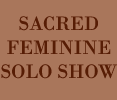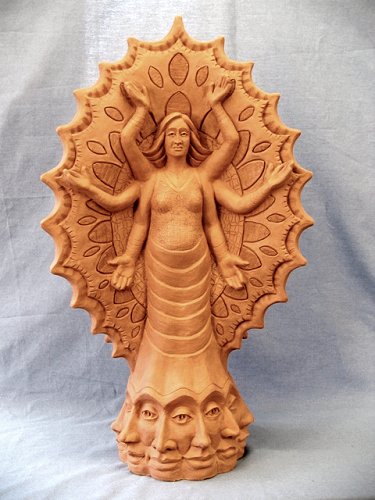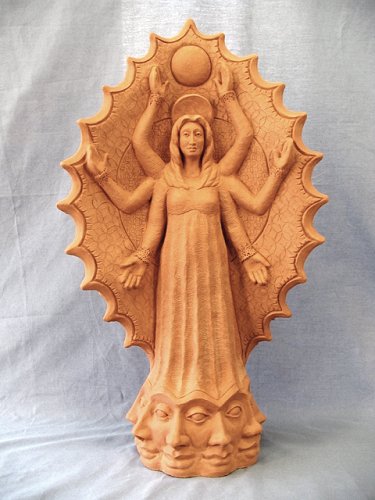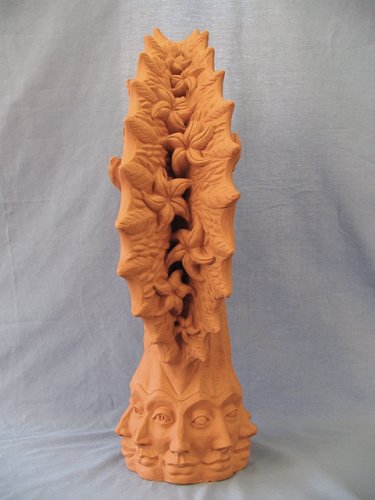
|
|
|
I used a spontaneous process to make Altar Goddess with Fish and Flowers, inspired by artists like Wassily Kandinsky and artists from the Surrealism movement, who worked directly from their subconscious in a stream of consciousness manner. They did not use a preconceived theme, rather they allowed colors and forms to emerge, prompted by subconscious emotions. I enjoyed the process of making a piece whose outcome I did not know. It was like reading a good book and not knowing what would happen next, kind of like life. The only idea I had when starting this piece was that I wanted to sculpt faces that were similar to the faces from my last piece Pope Joan with Miter Hats, Ganesh and Boubo into a base upon which a women would stand. I envisioned these faces melding together so that the eyes would be shared by the different faces. Other areas that I discovered which segued well were the eyebrows of the faces at the base of the sculpture which blended into the folds of the dresses of the woman who are standing on these faces. Perhaps the heads the two women are standing on are dreaming up these women, or the women are their thoughts. Or, possibly the two women are elevated by the ideas of their predecessors, represented by the many faces upon which they stand. As I started to work the idea formed in my mind that I wanted to make a woman with multiple arms in the style of art from India. Because I didn’t want the arms to be protruding where they can easily be broken off, I decided that I would frame the figures against a large mandorla shape that would add structural support. I placed a figure on each side of this mandorla shape. Then, I created two mandorla shapes that were back to back with the space in between creating long mandorla-like spaces on either side of the two figures. Into this space I eventually put fish on one side, and flowers on the other. This composition also created four “sides” to the sculpture inviting the viewer to explore the different sides of the piece. I used the mandorla and circle shapes in repeating motifs. It was fun to see what different shapes could metamorphous in and out of the yoni shape: eyes, fish, leaves, eyebrows, arcs, etc. As I mentioned before, none of these ideas were preconceived. Rather, I let ideas birth new ideas. I was very surprised that the many faces at the bottom of the piece were as easy to sculpt as they were. When I worked on Pope Joan with Miter Hats, Ganesh and Boubo it was really hard to get all the eyes/breasts the same size and shape. They needed to look consistent for that piece. However, for Altar Goddess with Fish and Flowers it works for each of the eyes, noses and eyebrows to be a bit different. Perhaps this is because our faces are unsymmetrical and we are used to that. As the piece is viewed straight on, the tips of the crescent shapes from the other side peek out from behind the concave areas of the crescent shapes. These forms then vibrate as the viewer moves around the piece, creating a layered halo around the edge of the piece. Margaret Starbird mentions in her book The Woman With the Alabaster Jar the concept of the Sister Bride, symbolic of combined passion and purity (p. 128). While reading her book I realized that the Sister Bride concept that she details is encompassed by my piece. On one side of my piece is a woman with a halo that references Mary Magdalene, the hypothetical wife of Jesus. On the other side is a woman representing a more sexual, and sensuous aspect, reminiscent of sculptures from India. These women represent the spiritual and the sensuous in harmony and two different faces, or aspects of the holy. The one woman is more traditional and conservative. Her dress is long and modestly cut; she wears a halo. The other woman is a more sensuous; her dress is more revealing and her body is more curvaceous. Her facial features are fuller and intense. To further highlight the aspects of the women the sides of the piece further illustrate each of them. The lush flowers at the sides of the sculpture relate to the sensuous woman. The tessellating fish on the other side narrate the woman with the halo. This piece was made in 2005, before my trip to India in November of 2005 and my interest in art from India heavy in influences this piece. When my Mom looked at this piece she understood at once what the three different pairs of arms of the women meant. The two bottom arms were in a position of openness, like the arms that one often sees of Jesus in paintings. The second pair of arms is giving a blessing and the third pair of arms is reaching upwards, towards wholeness. As I worked on this piece I began to envision it in the center of the room on an altar and people sitting around it so they could view the four different sides of the piece. Yet, least my discourses run to erudite, it is amusing to know where I got the idea for the mandorla pattern that surrounds the woman with the sleeveless dress. My son likes to watch the Three Stooges and these days just about every sentence of his starts with “Curly…”. Well, gosh, don’t you just wonder where this is going? Well, we were watching the Three Stooges’ Three Little Pirates and there is a scene where Curley is disguised like a Rajah in a robe that is covered with an exquisitely beautiful mandorla pattern. As soon as I saw this pattern I walked right into my studio and carved the design on this piece. As they say, the rest is history.
|





